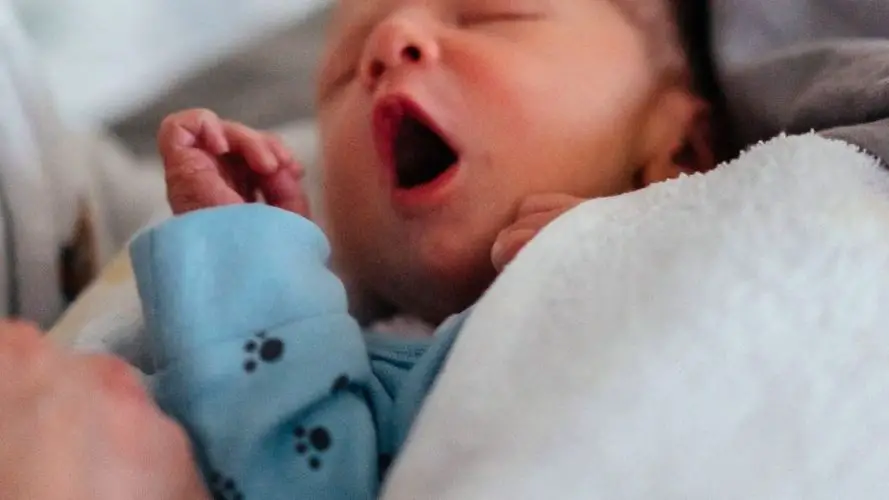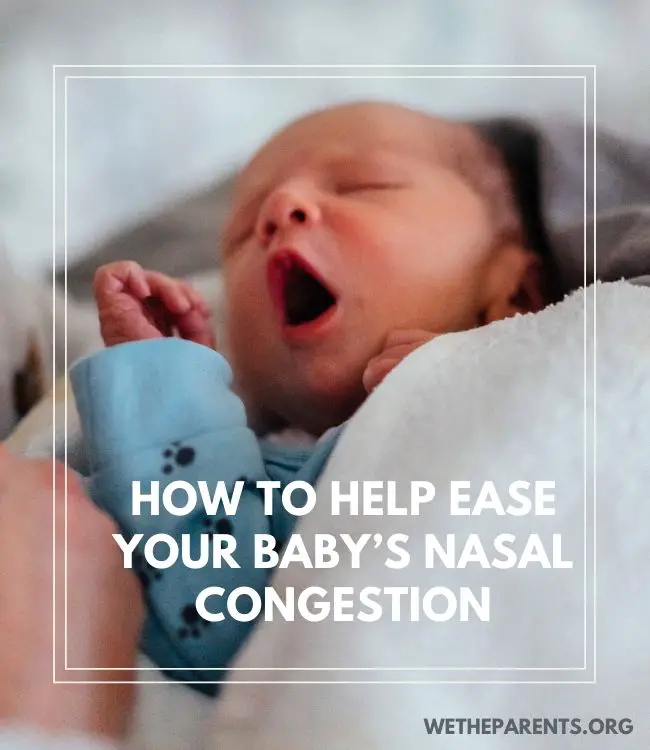Does your baby’s adorable button nose suddenly resemble a leaky faucet? If so, don’t fret. Babies are prone to nasal congestion for many reasons.
The good news is that, more often than not, sniffles will pass on their own. In the meantime, there are plenty of ways to soothe those stuffy noses.
How to spot a stuffy nose
Recognizing a stuffy sniffer might seem like a no-brainer, but were you aware that there are often symptoms that can go overlooked? Aside from the apparent discharge and sniffling, your baby might be nasally congested if she is:
- Snoring while sleeping
- Sneezing
- Having difficulty nursing
- Suddenly more fussy than usual
- Experiencing abrupt changes in sleep
- Coughing
Causes
Babies have small noses, which means that even a little swelling or increased mucus production can quickly clog up those tiny nostrils. But what are the underlying causes of stuffy noses?
Amniotic fluid
Does it seem like your newborn was born with a stuffed up nose? Don’t worry; this is more common than you might think.
Babies have been living and breathing in amniotic fluid safely inside your womb for many months. While they are being born, this fluid can enter their nose and cause swelling and congestion.
The good news is that this usually clears up on its own within a few days.16 Reasons Why Newborns Have Stuffy Noses
huffpost.com
Airborne irritants
There are plenty of unseen particles floating around the air that can enter your child’s nose and cause irritation leading to congestion. These can include:
- Dust
- Pet dander
- Smoke from cooking, cigarettes, cigars, or vape pens
- Perfumes
- Air fresheners
- Pollen
- Essential oils
Dry air
Breathing in dry air for long periods can cause inflammation of the nasal passages. This swelling can quickly lead to increased mucus production, and voilà, you have a congested kiddo on your hands.2The mystery of dry indoor air – An overview
sciencedirect.com
The common cold
Frequently caused by rhinoviruses — and a whole host of other viruses — the common cold can make for a miserable experience and non-stop congestion. Luckily, the symptoms usually resolve on their own after 10 to 14 days.
mayoclinic.org
Sinusitis
Also known as a sinus infection, sinusitis occurs when the ordinarily air-filled sinus cavities are filled with fluid and unable to drain naturally.
This type of blockage can arise from several things including the common cold, allergies, bacterial infection, and a foreign body lodged in the nose.
Sinusitis comes in many forms ranging from viral to bacterial, and from acute to chronic, with several subcategories in between.
Because of this, it’s essential to seek medical advice if you suspect your little one has developed sinusitis. Be on the lookout for swollen eyes, a fever, and thick, bright yellow or green mucus coming from the nose.3Lieser, J. D., & Derkay, C. S. (2005). Pediatric sinusitis: when do we operate?. Current opinion in otolaryngology & head and neck surgery, 13(1), 60-66.
Luckily, many forms of sinusitis will clear up within a few weeks with proper treatment.4Wald, E. R. (1992). Sinusitis in children. New England Journal of Medicine, 326(5), 319-323.
Foreign object
It’s no secret that babies explore the world in all kinds of ways. Unfortunately, one of those ways can be sticking objects up their nose.
Any foreign body lodged in the nasal cavity can cause an overabundance of mucus production, or, possibly, more severe consequences if left untreated.
How to treat stuffy noses
Although you can’t immediately cure a runny nose, several treatment options can temporarily relieve the symptoms.
Saline drops (or spray)
These little moisture droplets will quickly become your best friend when your kiddo’s sniffer is clogged. You can administer saline drops on their own to help loosen mucus and clear out irritants, or use them in conjunction with other nose-clearing methods.5Chirico, G., Quartarone, G., & Mallefet, P. (2014). Nasal congestion in infants and children: a literature review on efficacy and safety of non-pharmacological treatments. Minerva pediatrica, 66(6), 549-557.
Nasal aspirators
These handy gadgets are easy to find and come in a variety of models. Remember to always use a little saline before suctioning your little one’s nose. This will help loosen mucus and reduce the chance of a nosebleed.
- Bulb nasal aspirator: With a design true to its name, this light bulb-shaped aspirator is easy to use. Before placing into the nose, simply depress the bulb, then insert the tip slightly into your baby’s nostril, push down gently with your finger on the opposite nostril to plug it, and release the bulb to suck out excess snot.
- Oral suction nasal aspirator: Okay, this might sound gross to the uninitiated, but hear me out. This aspirator works by inserting one end of a tube into your child’s nostril and plugging the opposite nostril. You then insert the other end of the tubing into your mouth and gently suck out the mucus. You can control the suction level, and a filter protects you from accidentally eating baby boogers.
- Electric nasal aspirator: These are considered quite efficient at clearing out little noses. They don’t take up a lot of space and run on batteries or via a power cord. Some models offer features such as an adjustable suction level, ergonomic handle, and saline dispensers.
Clear the air
Regularly replacing air filters, frequent vacuuming, regular dusting, and putting the air fresheners and scented candles away can help keep the air in your home free of allergens.
By eliminating potential causes for congestion, your baby’s nose issues may begin to resolve on their own.
Hydration
Although congested babies might have difficulty taking in fluids, it’s essential to do your best to keep your congested child hydrated.
Babies that are nursing or taking a bottle have a difficult time doing so when their noses are clogged up because they then have to breathe through their mouths in between gulps.
So keep in mind that they will take only small amounts at a time before tiring out, and offer more frequent feedings.
Bathtime
If your baby is particularly fond of bathtime, you might just have a win-win situation on your hands. Break out all the best bath toys so that your little one will be distracted from her distress with some good old-fashioned free-play.
While enjoying herself, the warm water and steam will soothe her body and, hopefully, loosen some of that mucus.
Humidifiers
Humidifiers add humidity to dry air. When your baby breathes in this air, the moisture can help loosen and dislodge mucus. A humidifier with a cool-mist option provides non-invasive relief for stuffy noses.
Steam
If you do not have a humidifier, steam is the next best thing. Vaporizers will create steam, or you can take your little one to the bathroom and sit with the shower running until steam fills the room, then turn the water off.
Do this several times a day for up to 10 to 15 minutes at a time.6Natural Treatments for Coughs, Runny Nose and Congestion askdrsears.com/topics/health-concerns/childhood-illnesses/coughs-colds-sinus-infections/natural-treatments-coughs-runny
Facial massage
Gently rubbing the bridge of your baby’s nose, cheekbones, eyebrows, and hairline can help alleviate the distress associated with congestion.7Baby congestion treatments
healthline.com/health/newborn-congestion#treatment
Babywearing
Utilizing a baby sling or carrier will keep your little one in the best position for nasal drainage. After all, the more upright we are, the better gravity will work to clear up clogged sinuses for an all-natural remedy.
If you don’t have a baby carrier at the ready, hold your baby or rest him against your chest while you sit — just make sure he’s in an upright position.
Tummy time
Like wearing your baby, tummy time harnesses the power of gravity to help drain those sinuses. This technique often works best when used in conjunction with saline drops.
Treatments to avoid
While it can be tempting to reach for traditional medicines to blast away that congestion, it’s essential to never give your baby anything without clearing it with your doctor. 8You should avoid Sinus Infection
cdc.gov
- Over-the-counter cold medications
- Vapor rubs (in children under 2 years of age)
- Using your fingers or cotton swabs to dislodge mucus from the nasal passages of your baby
- Nasal strips (e.g., Breathe Right)
When to call a doctor
It’s never a bad idea to phone your pediatrician if you’re worried or have questions about your baby’s health, especially when the child is under three months old. In fact, always contact your doctor if your infant develops a fever.
Other signs that indicate a doctor’s visit is warranted include:
- Reddening of the eyes
- Greenish or yellowish discharge from the eyes
- Breathing difficulties
- A decrease in urine and/or stool output
- A lingering cough
- Thick, green nasal discharge for several days in a row
- Inability to get comfortable
- Unusually fussy
- Signs of ear pain
You should take your baby to the hospital if he:
- Stops nursing or refuses fluids
- Develops a severe cough that induces vomiting
- Has trouble breathing
- Develops a blue tinge around the lips
- Exhibits a change in skin color (e.g., becomes blue)
- Has a foreign object lodged in the nose9Common Cold in Babies.
mayoclinic.org

Mucus color matters sometimes
If you do call your doctor to seek advice, be ready to answer a few questions, including how often she’s been willing to nurse, changes in behavioral or sleeping patterns, and whether or not she is soiling her diaper regularly.
You’ll also need to tell the doctor a little about your baby’s snot, as mucus is an important diagnostic tool.
- Clear mucus: This can occur even in healthy babies, and can indicate your child either has a cold coming on or is suffering from allergies. Clear mucus can also signify that the body is merely trying to rid itself of irritants or that your baby has been breathing in cold air.
- White mucus: Babies often consume a lot of dairy, which can lead to that thicker, white mucus you occasionally see in and around their noses. This color indicates snot that has been sitting around in their nasal passage for a while. It can also occur if your baby has a cold, in which case you needn’t worry unless you see it continuously for two weeks or more. At this point, it’s time to call a doctor as your baby may be at risk of a sinus infection.
- Bright yellow or green mucus: Babies will sometimes wake up with green or yellow discharge from their nose. This is often normal, as bacteria can accumulate throughout the night and turn those baby boogers a funny shade. Seeing these colors occasionally does not automatically mean there’s a sinus infection.
Either of these colors can indicate just a common cold. They can be part of the body’s natural progression through an upper respiratory tract infection.10Don’t judge your mucus by its color
health.harvard.edu
It is a good idea to call your doctor if you see this type of nasal discharge persisting for longer than a week — or sooner, if your baby develops a fever or other signs of illness.11Puhakka, T., Mäkelä, M. J., Alanen, A., Kallio, T., Korsoff, L., Arstila, P., … & Ruuskanen, O. (1998). Sinusitis in the common cold. Journal of allergy and clinical immunology, 102(3), 403-408.
- Red/Orange/Brown Mucus: These colors occur when there is blood in the mucus. Red tints indicate a fresh bleed, and a brown color suggests the blood has been in the nasal cavity for some time. Like adults, babies are prone to nose bleeds due to cold, dry air, or over suctioning with a nasal aspirator. While not uncommon to see occasionally, you should contact your doctor if you notice this coloration for several days in a row.
- Gray/Black mucus: Either of these colors indicates that your baby’s body is working to expel some kind of inhaled pollutant or irritant naturally. While you should check to see if you need to improve the air quality in your home, these hues don’t generally indicate an underlying illness.
Conclusion
Congested babies are often unhappy ones, so it’s vital to know why mucus forms and how you can clear up their nostrils.
Don’t be discouraged if you have to try a few different techniques before opting for the one that works for your child. Once you’ve found the best way to clear your baby’s nasal congestion, it’ll feel as though you’ve struck gold!
Happy booger blasting, Mamma, and may your baby soon be back on the road to clear breathing.






